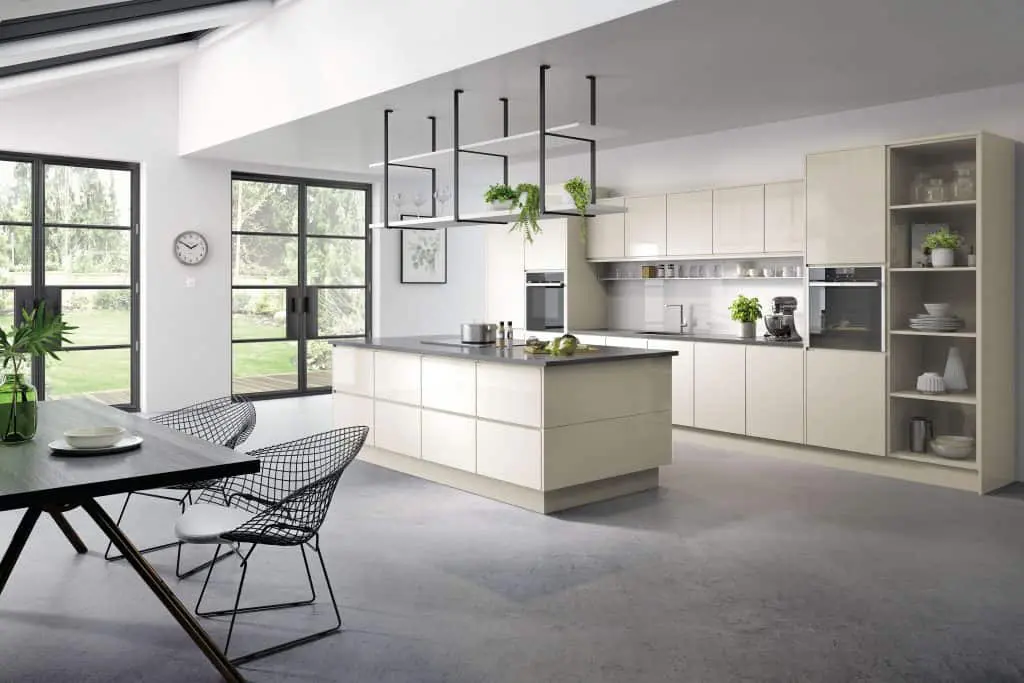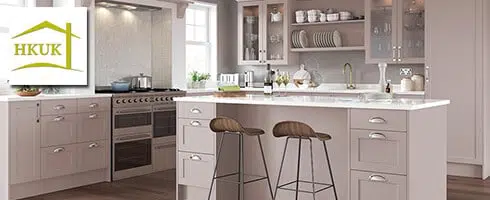
The manufacturer has general advice for keeping your kitchen doors looking in pristine condition:
The most common problems found occur as a result of excessive or prolonged exposure to heat and/or moisture.
Always ensure that water is not left around the sink areas as damage caused as a result is not covered by the manufacturer warranty.
Always wipe of excess moisture and be careful with extreme heat sources, such as kettles, ovens and toasters. It is recommended that these heat sources are not placed directly under any wall unit when they are in use as they generate a higher level of heat and moisture than is often expected and can quickly and easily lead to damage of the Goods.
Don’t place appliances that create steam (e.g. steamers, coffee makers or kettles) underneath the Goods.
If using glass cleaner to clean your glass doors be careful not to damage fine finish of the door and cabinet parts while cleaning. Do not spray glass cleaner directly onto the glass or cabinet as this may discolour the finish or your kitchen cabinets. Instead spray a small amount of the cleaner on a lint free cloth and wipe down the glass.
Don’t open the door of the dishwasher immediately once the cycle is finished as the exposure to the heat and humidity may cause the Goods to absorb the moisture and swell.
Please note that after a period of time it is quite normal for the colouring of kitchen units to mellow in colour. This is not a manufacturing fault and is a result of exposure to light. This means that any additional parts subsequently ordered, or supplied as replacements may not be an exact colour match. However, any additional Goods or parts supplied will also mellow over time to blend with your existing units. The colour of doors and drawer fronts may appear mismatched.
This apparent mismatch is sometimes the effect of differing light conditions within your room. To check your Goods you should place them side by side in natural daylight for comparison.
Cleaning Advice for all Kitchen Door Types
Do not use wax furniture polish, abrasive or aggressive cleaners, bleach or other chlorine based cleaners, multipurpose cleaners, dilutes, acetone, alcohol, solvent or similar products on the Goods, as this will damage the surface. Additionally wax and polishes leave a residue build up that is difcult to remove.
Only use a 1% soap, 99% water (liquid soap) solution, wiping with a damp (not wet) cloth, finally drying with a soft clean cloth only.
Ensure all cooking splashes are wiped immediately with a damp cloth.
Dust the Goods with a soft cloth only.
Never use any abrasive cloths or cleaners on the Goods. Spills and condensation on the Goods should be cleaned and dried immediately.
Our Goods should not be stored or installed in a newly plastered room or damp environment. If you need to store them for a while they should be kept flat, preferably in the room in which they are to be installed. This is of particular importance for tall/wardrobe doors.
Components placed adjacent or below a sink, or covering a dishwasher/washing machine or other water source are exempt from this manufacturer Warranty, unless the failure can be proven to be other than as a result of moisture penetration.
The Goods are wrapped in a manmade material, as are all similar ones in the kitchen and bedroom industry and should not be exposed to heat in excess of 60 degrees. To avoid damage caused as a result of exposure to excessive heat please follow these simple guidelines:
- When installing doors adjacent to ovens or other heat sources always ensure doors are shielded by the use of heat deflector strips.
- Never use an appliance that generates high levels of heat or concentrated steam (such as a toaster, kettle, pressure cooker or bread maker) directly under or adjacent to the Goods as this can cause damage.
Components damaged as a result of not following the above guidelines are not covered by the manufacturer Warranty unless protected by suitable heat strips and a suitable gap left for heat escape.
The correct care should help ensure that your Goods will look good for a long time.
All high gloss Goods should be allowed to “cure” for seven days after removing the protective film. During this curing process the Goods will be liable to scratching and other marks. Please treat the Goods very carefully during this period and avoid cleaning or wiping as much as possible.
To clean the surface of the Goods, wipe using a soft cloth with a mild nonabrasive, dishwashing detergent diluted in water. The mix should be 1 part detergent to 99 parts water. You should never use any vinegarbased detergents, solvents, abrasive detergents, white spirit or furniture polish.
We recommend the use of VuPlex polish with a micro antiscratch cloth.
Timber & Veneered Doors
It must be remembered that solid timber is a natural living product, therefore it is not possible nor desirable to achieve uniformity of grain or finish within the raw product. Timber will also change colour over time due to exposure to light. It is advised that this is taken into consideration when replacing or fitting new doors some time after the original installation. In addition to cleaning advice already detailed, it is recommended when cleaning timber doors care is taken to clean following the grain direction of the door using only a damp cloth.
Painted Doors
Painted finishes will change colour over time with exposure to light, the rate of change may differ between pieces and therefore is outside the control of the manufacturer and manufacturer Warranty.
As with timber doors, painted product is made from natural products which by their nature are subject to movement depending on the environmental conditions in which they are placed. This natural movement may cause shrinkage or hairline cracks in the paint or along the joints of the Goods. This is considered as part of the features of painted Goods and therefore exempt from this manufacturer’s Warranty.
Extreme care should be taken when cleaning painted Goods. In all circumstances use only a damp cloth with a 1% soap, 99% water solution.


